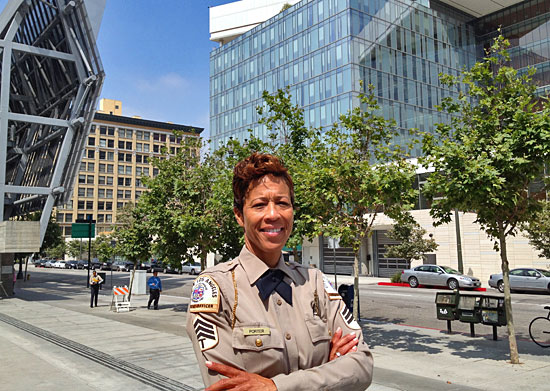Traffic officers ramp up, too
June 21, 2012
When it comes to L.A. traffic jams, they’ve seen it all—from the post-game Dodger blues to the most limousine-studded Academy Awards ceremony.
Now a hardy band of Los Angeles traffic control officers is going where they’ve never gone before: into the heart of the marathon construction project that will shut down Wilshire ramps to the 405 Freeway for an entire year. Their hand gestures and force of personality will be all that’s standing between the motoring public and utter gridlock at some of the most notorious intersections in the world.
To which Sgt. Kimmi Porter says: no problem.
“I think it’s going to work fine,” says Porter, of the city Department of Transportation. “We do our job and we do our job well. The first day might be a bump in the road, but people get used to it. They won’t like [the congestion] and they’ll find another way to go.”
Porter speaks from experience. A 26-year veteran who for more than two decades worked traffic control on the Westside of Los Angeles before moving to an administrative job downtown, Porter can tell you what to wear to direct traffic at the Oscars (that would be your “Class A” uniform with tie and long-sleeve shirt) and how local sports teams are drawing (after Chris Paul came to town, “we worked more Clipper games. I think we worked them all this year.”)
A sold-out Dodgers game (especially one with a giveaway) is an “A game,” and you never know what to expect.
“On any given night, it can go either way. They’re fine going in, but when they come out, they’re excited if they win. The windows are down and they’re screaming.”
And she knows at a glance how things will go at the Hollywood Bowl depending on which acts are on the bill.
“The Philharmonic crowd, they’re coming to hear the music and leave. They come on time; they want to leave on time,” she says. “The rock crowds, they come in limos. They may not come for the first act. They’re more of an unpredictable crowd.”
You might think that traffic control officers, with their high visibility, would be lightning rods for L.A. motorists’ aggravation, but usually that’s not the case.
“We just get a small percentage that become irritated, frustrated or annoyed,” Porter says. “For the most part, the drivers obey and they comply with all the hand signals.”
The first of the Wilshire ramp closures start at 10 p.m. Friday, with work on the westbound onramp to the northbound 405 and the northbound 405 off-ramp to westbound Wilshire. This first round of ramp work is expected to take 90 days; after that, closures between 14 and 90 days are expected as workers demolish and rebuild each of the eight ramps over the course of the year. (Advance work to prepare Sepulveda Boulevard as an alternate route begins tonight, Thursday, June 21, at 10 p.m. Details of all the upcoming closures are here.)
There will be 37 traffic officers deployed at key intersections, under the command of West Area Captain Tom Villarreal.
He says his people are being reminded to be “very respectful” of motorists struggling to get through the area.
“I think during peak hours it will be very heavy, very congested, and there might be some frustrated people,” he says. “This is going to be a big undertaking.”
In addition to patience, Porter says, the officers will need to bring their “command presence” to the job—force of personality, along with the “halt” gesture and a few steps forward, usually are enough to deter the most impatient motorist itching to jump into the intersection on a red light.
Over the years, Porter has developed a certain empathy for what drivers have to endure—and has witnessed how they eventually end up coping with any obstacles thrown in their path. Westside drivers navigating the long-running Wilshire ramps work will most likely follow the same pattern, she says.
“I would not say that the Westside driver is different than any other driver,” she says. “I just think with the closure there’s going to be some frustration, of course, because they want to get home or go to work. The detours are going to delay them. I think what’ll happen is people will become frustrated in the beginning. But what people tend to do is they’ll find other routes. They’ll stay away.”
In those early days, though, if you’re passing through the area and spot a traffic control officer working an intersection, you might want to give a friendly wave (and not the other kind of hand gesture our traffic can inspire.)
Because, as Porter points out: “If we weren’t around, we’d be missed.”
Posted 6/21/12













 405 bridge work causes a stink
405 bridge work causes a stink
